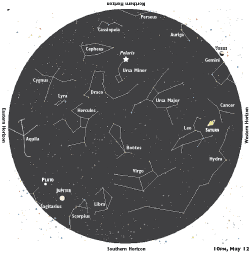The Planet of Love’s Other Face
A hellish atmosphere of greenhouse gases and acid rain
The sun sets around 8:10 this week, and it isn’t another hour until dusk cedes to darkness. But by 9:00, a glimmer of light pierces the sky high in the west like a reflection from a passing jet. The light remains fixed, however, the darkening sky adding to its brilliance. And as other stars blink into view, this evening star shines all the more bright by comparison.
Venus, our nearest neighboring planet, outshines all but the moon, which wanes in pre-dawn skies from last-quarter Thursday the 10th to new moon the following Wednesday. More than proximity makes for Venus’ brightness, however. The planet of love is surrounded by a dense atmosphere estimated to be 40 miles deep.
Composed almost entirely of carbon dioxide, Venus’ atmosphere is a smog-filled hell that reflects more than 70 percent of the sunlight that hits it back into space. What’s left to the atmosphere is literally acid rain, a mix of sulfuric acid, chlorine and fluorine. But in an atmosphere 90 times more dense than that of Earth (equal to the pressure one-half mile underwater), this toxic stew evaporates before ever reaching the surface.
The dense atmosphere lets nothing escape the planet’s surface, either. Beneath the cloud mass, a perpetual greenhouse effect holds temperatures near 900 degrees Farenheit, well beyond the melting point of lead.
Even science cannot withstand Venus. In 1970, the former Soviet Union became the first nation to send an unmanned craft, Venera 7, to another planet. Too bad they chose Venus. Within minutes, the extreme heat and pressure destroyed the spacecraft. Another seven Venera missions followed, the longest surviving not quite 10 minutes.
Tidelog®
Illustration: © Copyright 1925 M.C. Escher/Cordon Art-Baarn-Holland; Graphics: © Copyright 2007 Pacific Publishers. Reprinted by permission from the Tidelog graphic almanac. Bound copies of the annual Tidelog for Chesapeake Bay are $14.95 ppd. from Pacific Publishers, Box 480, Bolinas, CA 94924. Phone 415-868-2909. Weather affects tides. This information is believed to be reliable but no guarantee of accuracy is made by Bay Weekly or Pacific Publishers. The actual layout of Tidelog differs from that used in Bay Weekly. Tidelog graphics are repositioned to reflect Bay Weekly’s distribution cycle.Tides are based on National Oceanic and Atmospheric Administration and are positioned to coincide with high and low tides of Tidelog.
